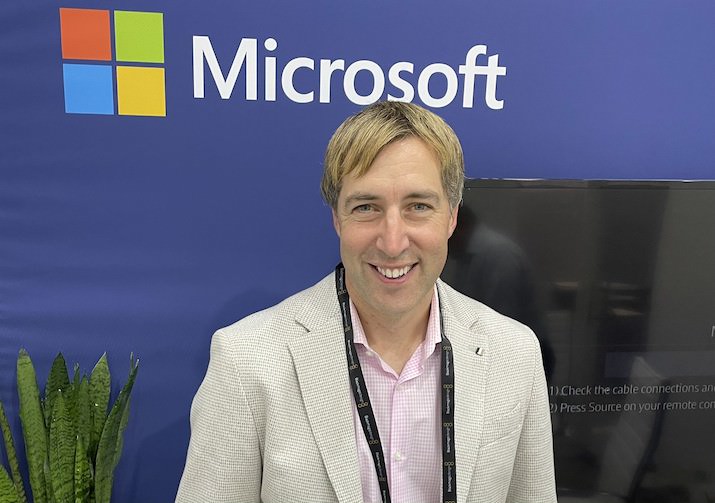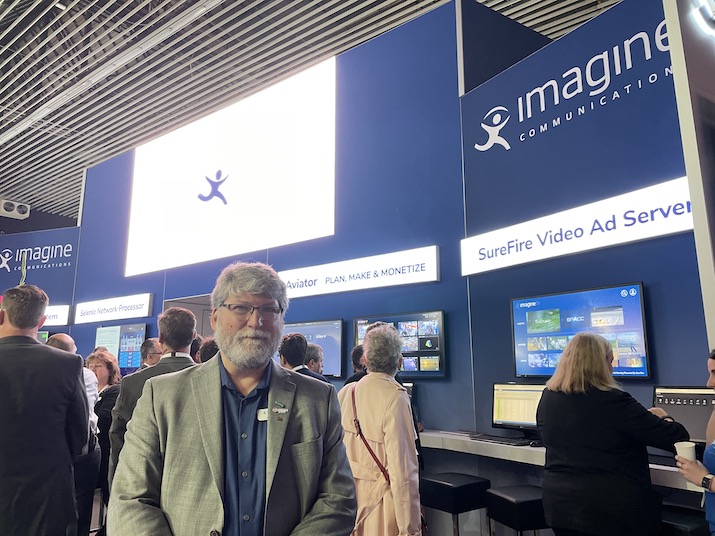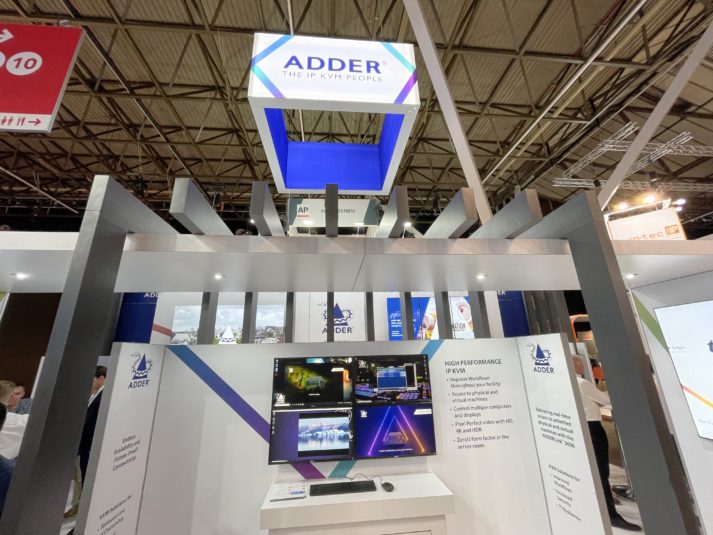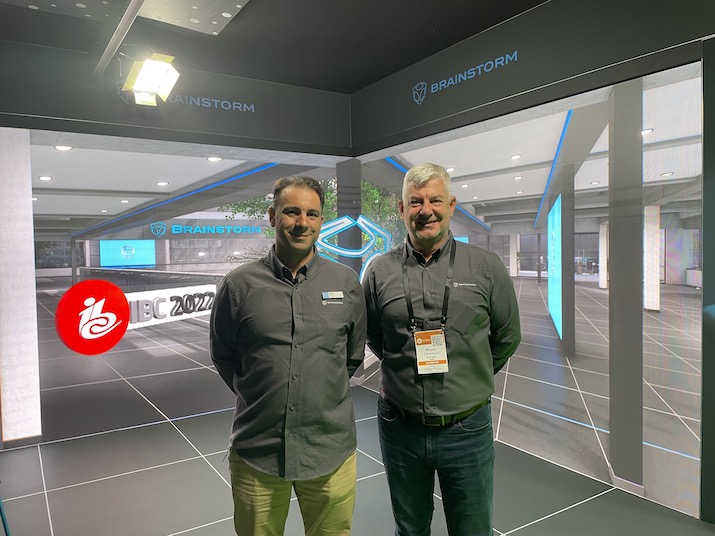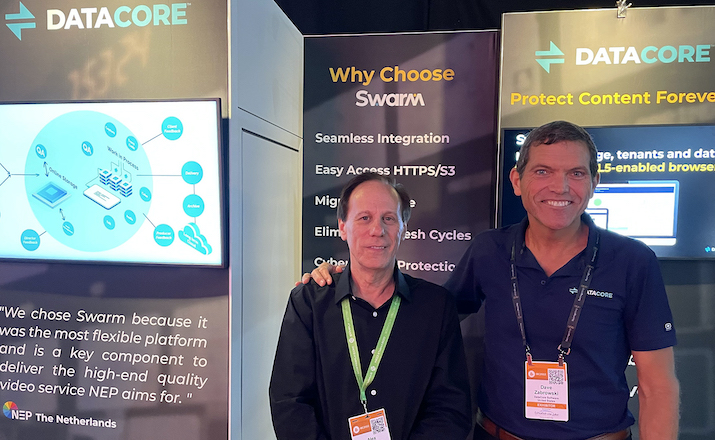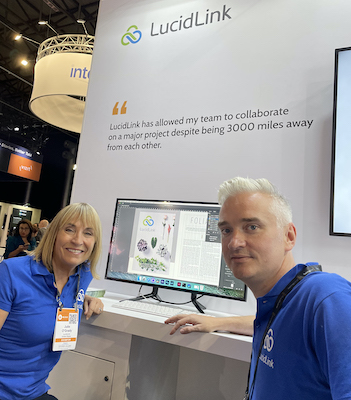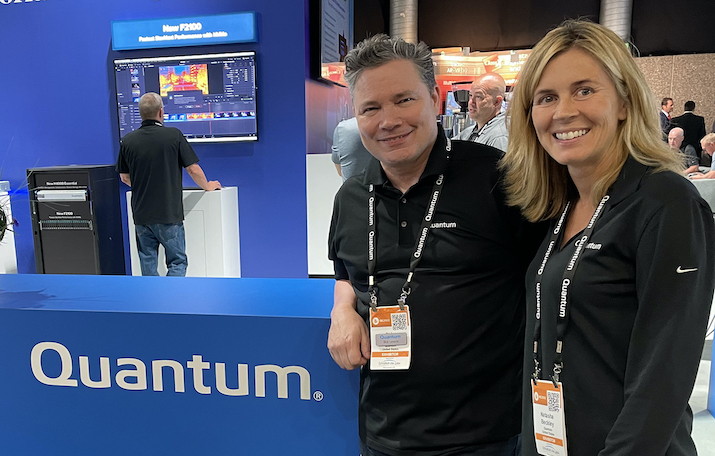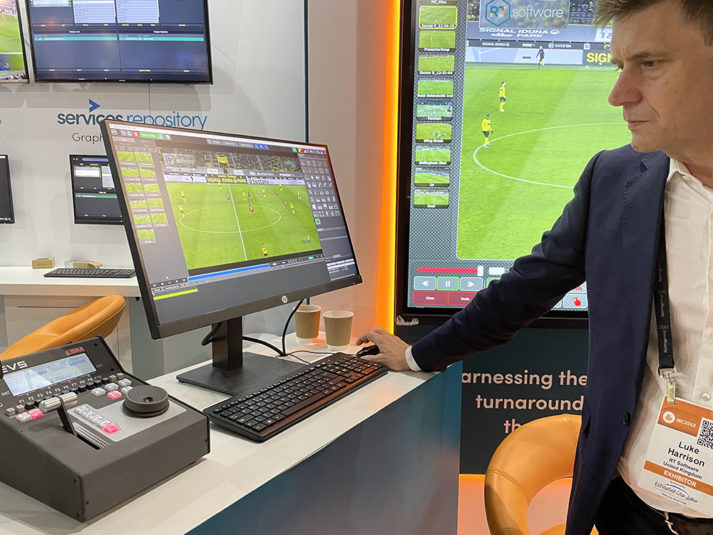IBC 2022 in Review, Part 1: Halls 1-7 Featuring Amagi, AWS, Blackmagic, Dolby, LiveU, Lumen, NEP, Zixi, and More
Also news from Adder, Editshare, Evertz, Imagine, Microsoft, Quantum, Rohde & Schwarz, Signiant, Telestream, and TVU
Story Highlights
The SVG and SVGE editorial teams were out in full force at IBC 2022, covering the biggest sports-technology news and delivering daily live roundups. Here is a look at the news from exhibitors in Halls 1-7.
Featured in this roundup are Accedo, Adder Technology, Amagi, Amazon Web Services, AJA Video Systems, Appear, Ateme, Blackmagic Design, Brainstorm, Broadpeak, DataCore Software, Disguise, Dolby.io, Edgio, EditShare, Evertz, Fastly, Grabyo, Haivision, Imagen, Imagine Communications, LiveU, LTN Global, LucidLink, Lumen, Matrox, Media Links, Microsoft, NEP Group, Net Insight, Phenix Real-Time Solutions, Pixotope, Quantum, Rohde & Schwarz, RT Software, Sencore, SES, Signiant, ST Engineering iDirect, Studio Network Solutions, Synamedia, TAG Video Systems, Telestream, Tellyo, Telstra Broadcast Services, TVU Networks, Veritone, Vislink, VITAC, Zero Density, and Zixi.
HALL 1
Oslo-based media-processing and -delivery–technology firm Appear (Stand 1.C61) has its sights set on the U.S. Chief executive Thomas BostrØm JØrgensen is keen for it to take a “significant position” in the country: “For the first time, we are marketing the Appear brand in the U.S. The speed of maturity and adoption of networking technologies are different to the U.S. than in Europe, and that is a big thing for us.” Appear products related to mezzanine compression and the adoption of ST-2110, he added, are ripe for the U.S. market. Former Nevion senior architect Geoff Bowen, who joined Appear this year, is the company’s technology lead and solutions architect in the U.S. Also at IBC, Appear is sharing details of its three-year project with Deutsche Telekom to reduce latency on the telco’s OTT platform to where it is on a par with the latency of satellite and cable delivery.
Ateme (Stand 1.D71) and Viaccess-Orca have partnered to offer a new service for creation of VOD-to-live and personalised live channels with targeted ads. Ateme is providing its NEA offering for streaming, integrating server-side ad-insertion technology with VO’s AI-based content-discovery and targeted-ad product, which is driven by usage data, viewing preferences, and subscriber consumption patterns.
Broadpeak (Stand 1.B79) has added dynamic ad insertion as a service for users via Broadpeak.io, the company’s API-based SaaS platform, which launched in January. The monetisation tool is the third offering on Broadpeak.io, which also includes a content-replacement tool and a pop-up–channel service known as Virtual Channel.
Caton Technology (Stand 1.F36) is touting the benefits of IP transmission, with the message that IP transmission is robust and efficient enough for primetime content and not just for backup or low-value media. According to Caton Technology SVP, global operations, Gerald Wong, CatonNet Video Platform (CVP) can provide a comprehensive service to link any event to any broadcaster around the world, with Caton’s recent implementation of the first stage of a new contribution network for NBA, MLB, and Premier League rights-holder Eleven Sports in Taiwan given as an example of the technology in action.
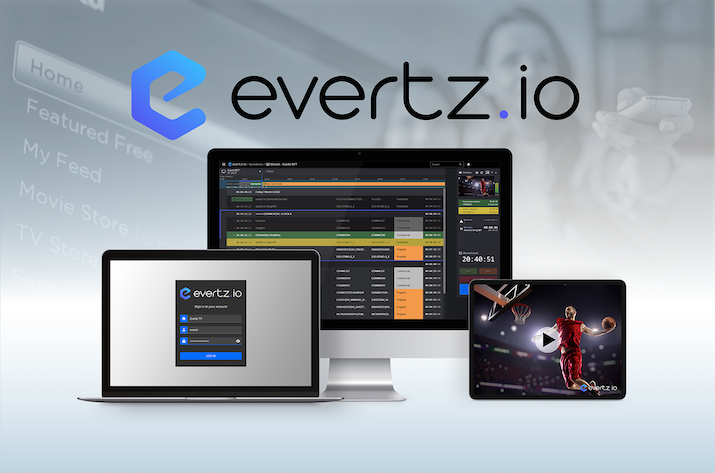 Evertz (Stand 1.F76) is highlighting its Software-as-a-Service solution Evertz.io for live sport rights holders to launch new channels and monetise content via OTT and D2C platforms, connected TVs, and traditional broadcast distribution and streaming applications. The platform, which offers hourly, daily, and monthly pricing models, provides features found in enterprise class broadcast playout systems, including live inputs, video and audio mixing, multi-language captioning and subtitling, and full graphics and branding capabilities, Evertz said. “Alternative and hyper-targeted channels that would previously have been too costly or too niche to launch can now be explored and monetised, enabling broadcasters and content creators to maximise their assets and increase revenues,” said Martin Whittaker, technical product director, MAM and automation, Evertz.
Evertz (Stand 1.F76) is highlighting its Software-as-a-Service solution Evertz.io for live sport rights holders to launch new channels and monetise content via OTT and D2C platforms, connected TVs, and traditional broadcast distribution and streaming applications. The platform, which offers hourly, daily, and monthly pricing models, provides features found in enterprise class broadcast playout systems, including live inputs, video and audio mixing, multi-language captioning and subtitling, and full graphics and branding capabilities, Evertz said. “Alternative and hyper-targeted channels that would previously have been too costly or too niche to launch can now be explored and monetised, enabling broadcasters and content creators to maximise their assets and increase revenues,” said Martin Whittaker, technical product director, MAM and automation, Evertz.
Evertz (Stand 1.F76) is reintroducing its Studer range of audio products in Amsterdam. After Evertz acquired Studer in early 2021, Mo Goyal, senior director, international business development, live media production, said it became apparent at NAB 2022 that some in the industry needed a little reminder of the addition to the Evertz range. At IBC, Evertz is highlighting its investment in the Studer lineup, which has been refreshed to include IP functionality and integration into Evertz live-production workflows, with Studer Vista digital consoles and Infinity Core audio mixing and processing now part of Evertz Software Defined Video Networking (SDVN) solutions.
Imagen (Stand 1.C37D) has launched prepackaged delivery workflows to leading OTT platforms. The Imagen platform auto-packages finished content according to the specific needs of each OTT platform, such as metadata, format, artwork, and resolution. Imagen chief executive Charlie Horrell said that OTT delivery workflows “remove considerable friction from the content lifecycle, reducing the amount of time spent manually delivering content and enabling teams to scale their delivery without limits.” Imagen’s clients include English Premier League, International Tennis Federation, and National Basketball Association.
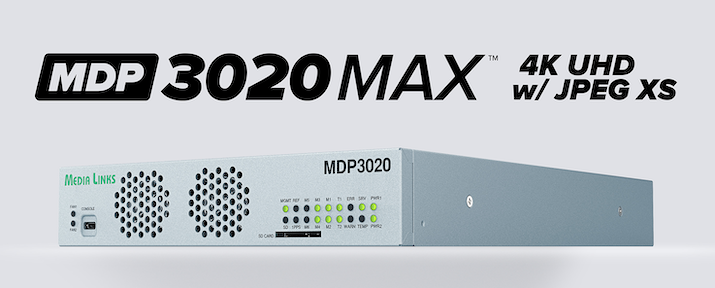 Media Links (Stand 1.C45) is launching its 4K, JPEG-XS version of the MDP3020 MAX IP Media Gateway. The SMPTE standards-based MDP3020 MAX is aimed at live, remote-production broadcast applications where network edge bandwidths are constrained and time-sensitive, immediate interaction between the studio and venue(s) is a necessity. It has been enhanced with support for two 4K-UHD/12G SDI video channels; it processes incoming 4K, 12G SDI video and audio streams by applying JPEG-XS compression and then encapsulating content into packets for transport over an IP network.
Media Links (Stand 1.C45) is launching its 4K, JPEG-XS version of the MDP3020 MAX IP Media Gateway. The SMPTE standards-based MDP3020 MAX is aimed at live, remote-production broadcast applications where network edge bandwidths are constrained and time-sensitive, immediate interaction between the studio and venue(s) is a necessity. It has been enhanced with support for two 4K-UHD/12G SDI video channels; it processes incoming 4K, 12G SDI video and audio streams by applying JPEG-XS compression and then encapsulating content into packets for transport over an IP network.
Microsoft (Stand 1.D25) has teamed with several partners on a sports-centric demo that features live sports commentary produced on the convention floor. According to Simon Crownshaw, director, worldwide M&E strategy, Microsoft, the company is showcasing a variety of “camera-to-cloud” workflows. In addition, demos include highlighting, clipping, timeline management, conversion, monitoring, and other production needs in conjunction with Evertz, Cinnafilm, swXtch.io, and Support Partners.
Net Insight (Stand BS18) has consolidated its R&D efforts and has established a new CTO group led by Ulrik Rohne, with Per Lindgren taking on the role of group CTO and head of sync. At IBC, the company is also highlighting its “offensive investment in 5G sync” and updates to its Nimbra platform. Lindgren told SVG, “Our key customers are service providers, but we also see, especially with our Gateway products, that we are much closer to production companies and sports broadcasters because the network is more important to them when they move to IP and remote and distributed production workflows.
Sencore (Stand 1.F72) has launched the SaaS-based Centra Gateway network-orchestration system. Senior Product Manager Aaron Doughten described Centra as “an end-to-end, holistic mothership of orchestration” that allows broadcasters to manage their entire media chain from a centralized, intuitive interface either located in the cloud or installed onsite. Although Sencore plans to expand functionality over the upcoming year, the IBC-ready release features the core functionality of the Centra Gateway: the reception, transmission, and conversion of internet protocols (RIST, SRT, Zixi, and HLS, along with MPEG-over-IP) for optimised distribution of video.
SES (Stand BS10-BS11) and LiveU are showing their joint offering of an end-to-end solution for live video contribution and distribution. Aimed at customers looking to broadcast live sport from stadiums and remote sites, the turnkey solution includes LiveU’s 4G/5G mobile field units as an alternative to onsite SNG trucks plus the ability to aggregate content in the LiveU Matrix IP cloud service along with distribution via SES global satellite and IP network.
ST Engineering iDirect (Stand 1.A49) is launching its MCX8000 multi-carrier satellite gateway, which enables broadcasters to cater to every type of broadcast scenario, including high IP encapsulation rates for OTT applications. According to VP, market development and strategy, Jo De Loor, the unit’s hot-swappable design allows users to avoid downtime for repairs and reduce operating expenses (OPEX). The energy-efficient MCX8000 also features the company’s Clean Channel Technology, which ensures high bandwidth efficiency and thus also lowers OPEX. The brand-new, intuitive interface is designed to streamline the entire process, reducing the requirement for specialist knowledge.
Studio Network Solutions (Stand 7.A26) has unveiled updates to its EVO Suite of workflow tools: new features for ShareBrowser media-asset manager (MAM), Slingshot automations engine, and Nomad remote editing utility included with the EVO shared-storage workflow solution. In addition, according to marketing manager Melanie Ciotti, key enhancements to the EVO Suite include transcoding for Blackmagic, RED, and ARRI RAW files (as well as faster transcoding time), custom watermarking and burnt-in timecode (BITC) for proxy files, and improved integration with NewTek TriCaster workflows.

TAG Video Systems’ Media Control System (MCS) works in tandem with the company’s Multi-Channel Monitoring systems.
After initial launch at NAB 2022 in April, TAG Video Systems (Stand 1.C30) will introduce its Media Control System (MCS) to the European marketplace. Working in tandem with the company’s Multi-Channel Monitoring systems, MCS is tasked with promptly aggregating, managing, and orchestrating newly collected data. To further refine the workflow, the product is relying on the new Bridge Technology, which removes the complexity of routing the same stream to diverse locations with an ultra-efficient architecture, enables an operator to receive a source once and display it directly on any TAG system, and automatically optimizes the sizing, format, and delivery protocol to fit the configuration of multiple recipients. Alongside MCS, TAG Video Systems will showcase enhancements and new resources for the Multi-Channel Monitoring solution. The improvements include under-monitor display (UMD) with expanded UMD and tally functions, internal timers, and tight integration with the popular Plura series of MTD production timing devices.
Tellyo (Stand 1.C37) has extended the hardware options for pro users of the cloud production platform, with a Loupedeck editing console and Behringer mixer in use on the company’s stand. “Many of our customers work in time-sensitive situations so we want to make the platform intuitive and even quicker to use,” said Tellyo Head of Marketing and Communications Stuart Russell, citing client Sunset + Vine, which recently had to work to a 20-minute deadline for clipping and uploading content from Henley Royal Regatta rowing event to YouTube. Tellyo has also made some enhancements to the live-clipping, -editing, and -streaming platforms, with updates to make it easier to work with clips containing multiple audio files and the ability to manually tag and categorise content according to criteria or activity.
Veritone (Stand 1.A15) is demonstrating its range of AI solutions at IBC. The Veritone Digital Media Hub allows users to monetise content via the use of AI-powered tools to sort, tag, and segment media, which Veritone said can be done in a fraction of the time required by traditional asset-management solutions. Veritone’s clients include Globo and Extreme E.
 Vislink (Stand 1.A63) has launched the Vislink 5G 4Live end-to-end remote-production solution designed to provide a premium-quality, uncontended 5G private network solution. It follows Vislink’s participation in 5G trials with the BBC and BT Media and Broadcast at the Birmingham Commonwealth Games and at Premiership Rugby. The 5G 4Live solution, which will be demonstrated at Vislink’s stand in Hall 1, has been designed for use at major events where live-production organisations have traditionally deployed COFDM systems. It enables live production with full support for wireless cameras, providing freedom for operators to roam and gather footage.
Vislink (Stand 1.A63) has launched the Vislink 5G 4Live end-to-end remote-production solution designed to provide a premium-quality, uncontended 5G private network solution. It follows Vislink’s participation in 5G trials with the BBC and BT Media and Broadcast at the Birmingham Commonwealth Games and at Premiership Rugby. The 5G 4Live solution, which will be demonstrated at Vislink’s stand in Hall 1, has been designed for use at major events where live-production organisations have traditionally deployed COFDM systems. It enables live production with full support for wireless cameras, providing freedom for operators to roam and gather footage.
Zixi (Stand 1.D81) is exhibiting an integrated Marshall CV630-IP camera at the RAI, following a partnership between the two firms. The tie-up means that Marshall cameras now include native support for Zixi-enabled delivery with compatibility extending to all Marshall Broadcast and pro AV-over-IP solutions. All standard IP camera versions can be loaded with the Zixi-enabled firmware allowing existing Marshall operators to add Zixi support to their cameras. Zixi SVP, Alliances, John Wastcoat said, “Marshall has an excellent reputation in the broadcast community with their feature-rich cameras, and we look forward to a fruitful partnership.”
HALL 2
Disguise (Stand 2.A35) has turned its attention to live productions, with sport a particular area of focus following the March acquisition of Polygon Labs. At IBC, the company’s stand is dominated by an XR stage and highlights integrated hardware and software comprising the new Porta 2.0 cloud app and px hardware for creating and controlling real-time XR, AR, CG, and ticker graphics via a web browser.
Having completed acquisition of Aviwest, Haivision (Stand 2.B36) is demonstrating the latest 4K/UHD bonded-cellular technology for live event broadcasts from anywhere. Included is a to-be-announced addition to its solutions portfolio. With HEVC image quality and powered by both SRT and SST protocols, Haivision mobile contribution solutions (including the PRO460 video transmitter and StreamHub transceiver) offer the solid workflow flexibility and the low end-to-end latency over 5G networks. Other key Haivision themes at the show are decentralized remote production using its Makito X4 series of low-latency video encoders/decoders and new cloud technology for intuitive central management of live streams, transcodes, and routing workflows.
Furthering implementation of IP is a goal of Imagine Communications (Stand 2.B49). Responding to the increased demand of remote workflows within hybrid production environments, according to CTO, Networking and Infrastructure, John Mailhot, the company is strengthening the power of the Selenio Network Processor (SNP). Features include DSP-enabled advanced audio processing, coordinated switching of 8K signals to support multi-stream workflows, and enhanced JPEG XS connectivity offerings. Another tentpole of Imagine’s efforts in sports-video production, the Magellan Control System has received notable additions. The software adds support for the latest versions of Cisco Nexus Dashboard Fabric Controller (NDFC) and Arista CloudVision Extension (CVX) Media Control Service (MCS). Also at the RAI, Imagine is partnering with Singular.live for its new Aviator platform. Built on top of this web-based offering, Singular.live enables secure access and operating control of graphics and other aspects via a simple internet connection.
HALL 5
Accedo (Stand 5.D65) is talking about a range of things at IBC, but perhaps of most interest to sports broadcasters and federations is a tie-up with JUMP Data-Driven Video. The offering combines the two companies’ data and UX expertise to provide rights holders with audience insights that they can quickly and automatically respond to and monetise. Existing data and user experiences are analysed to deliver a growth strategy that the company says will help broadcasters increase user retention and unlock new revenue streams. Another interesting development is a proof of concept with AWS for what they are calling “shoppable TV”, a concept that combines e-commerce with video content and allows viewers to interact with shoppable items in the video. For example, a footballer’s shirt could be made available to buy online seconds after the player scores a goal during a live-streamed match.
Amagi (Stand 5.C76) is showcasing the latest version of its flagship ad-insertion product. Highlights of the third generation Amagi THUNDERSTORM include increased render rates, availability on customer’s cloud, increased revenue opportunities with non-linear ads, improved CPMs with contextual targeting, and higher reliability.
Amagi (Stand 5.C76) has rolled the latest versions of its Amagi LIVE low-latency live-orchestration solution and Amagi CLOUDPORT channel-playout platform. Amagi LIVE, which was used by NBC Sports Group for the Tokyo Olympics in 2021, dynamically manages a variety of live productions for linear and VOD channels. A new enhanced user interface combines such functions as playlist view/edit and management of file-based and live content. Meanwhile, the latest version of Amagi CLOUDPORT features an enhanced user interface for more-efficient operation by a single user, and playlist additions — editing layout, viewing of past/current/future items, search/replace of assets, search filters, playlist versioning, show and break management, and missing-asset identification — make programming simpler and faster.
Amazon Web Services (Stand 5.C80) is hosting an all-day takeover of the Showcase Theatre in Hall 12 on Saturday, with presentations by AWS customers and partners on the transformative power of the cloud. At 2 p.m. on Saturday, Dave Duvall, CIO, Warner Bros. Discovery; Scott Young, SVP, Content and Production at Warner Bros. Discovery Sports, Europe; Marc Aldrich, GM, Media and Entertainment; and Julie Souza, Head of Sports, Professional Services, AWS, will discuss how Discovery Sports is transforming its broadcast and production workflow to tell more data-driven stories and boost audience engagement. In addition to the Showcase Theatre, AWS will demonstrate camera-to-consumer workflows powered by AWS and its partners at 5.C80.
Amazon Web Services (Stand 5.C80) is on a recruitment drive, with a particular focus on those with experience in artificial intelligence (AI) and machine learning (ML). “Data in sport is prodigious,” said AWS head of sports global, professional services, Julie Souza. “Tracking data from the field of play and being able to turn that data into insights that serve leagues and teams and fans is no small task. If you look at F1, we are collecting 1.1m data points per second from the cars. From a sports perspective, I would love more expertise around that. We already have some brilliant minds in AWS, but there is so much data, and the more folks we can have thinking about how we can use that to engage fans, the better.”
Low latency capabilities and better audience insights are two themes for Brightcove (Stand 5.B34) at IBC. With sports broadcasters and streamers in mind, the company is not offering the ultra-low latency required for sports betting but, instead, is putting its efforts into providing solutions to what it calls the “Twitter problem,” where a viewer might find out on social media that a goal has been scored or a wicket has been taken before it’s shown on the live stream they are watching. The latency required between 3 seconds and 8 seconds for a multichannel experience. There are trade-offs, the company notes. DRM is difficult with speeds this low, for example, and so stream encryption is used instead. At the same time, the company is offering its customers improved insights so that they can better understand how people engage with their content and how that content is performing and then are able to automate strategies to increase further engagement.
Dolby.io (Stand 5.A10) is focused on streaming with high-quality and high-fidelity audio. A key differentiator in a crowded market is the ability to deliver high-quality streams around the globe with latency of less than half a millisecond and at scale. A new data center is operational, increasing Dolby.io’s capabilities as clients take advantage of APIs to live-stream events and more via RTMP to a variety of third-party services, such as Twitch, YouTube, and Facebook. High-quality codecs like AAC are an option as well.
Edgio (Stand 5.A73) is focusing on speed and security at IBC, especially when it comes to how sports organisations provide web services to viewers and fans. Subsecond payloads are crucial, especially when it comes to e-commerce applications, but also speed to market with D2C OTT workflows via the company’s streaming division. Both topics are key for the edge-enabled–solutions provider, which is exhibiting at IBC for the first time since being rebranded from Limelight. This year, Limelight Networks entered an agreement to acquire Yahoo’s Edgecast in an all-stock transaction worth approximately $300 million. The relaunched company is being reintroduced to media companies at IBC.
Edge cloud platforms are of great interest at IBC 2022, and the Fastly (Stand 5.D28) suite of edge compute, delivery, and security offerings has arrived at the show with a unique partner on board: the Mercedes-AMG PETRONAS Formula One Team. “Our fight for milliseconds on the track relies on the strength of our digital infrastructure and the speed of our network,” says Mercedes-AMG PETRONAS Formula One Team IT Director, Michael Taylor. “Joining forces with Fastly, who share our obsession for innovation and uncompromising performance, will help drive us forward on the track and power our fan experience in the virtual world.” Adds Fastly CMO Margaret Arakawa, “The Fastly and Mercedes F1 partnership showcases two brands that are synonymous with performance and speed at global scale. Fastly is excited to push the limits of speed and security alongside a team that is not only one of the most legendary names in global motorsport.”
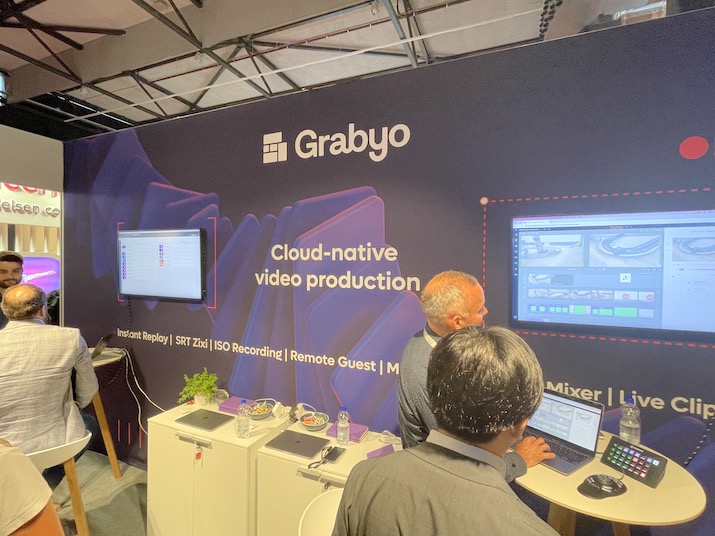 Grabyo (Stand 5.F45) is showcasing a handful of new enhancements to its existing workflows. Instant Replay, the new cloud-based solution, is accessible via any web browser. To develop more services for live productions, Grabyo is pairing Instant Replay with other techniques, including slow-motion controls and a new media-playout system. In addition, Grabyo is bolstering its Grabyo Producer platform with new features. At the top of the list are Key and Fill graphics to diversify the layout of any live stream, Custom Graphics Transitions to differentiate the live video feed and the inserted replay, and Asset Snapping that automatically aligns content to the desired location.
Grabyo (Stand 5.F45) is showcasing a handful of new enhancements to its existing workflows. Instant Replay, the new cloud-based solution, is accessible via any web browser. To develop more services for live productions, Grabyo is pairing Instant Replay with other techniques, including slow-motion controls and a new media-playout system. In addition, Grabyo is bolstering its Grabyo Producer platform with new features. At the top of the list are Key and Fill graphics to diversify the layout of any live stream, Custom Graphics Transitions to differentiate the live video feed and the inserted replay, and Asset Snapping that automatically aligns content to the desired location.
LTN Global (Stand 5.A77) is talking to sports-rights owners and holders about how it can provide reliable video-transport services that go beyond private-line networks, including satellite. This comes in the form of LTN Wave, a terrestrial IP-based distribution solution designed as an alternative to satellite distribution, enabling broadcast-quality multicast distribution over IP. Monetisation is a key focus for the company, too, especially where it can help with cloud-based versioning. This is done using LTN Arc, a fully managed production service that enables users to deliver customised streams and extend reach across platforms and geographies, and LTN Lift, a cloud-based playout solution with automated versioning capabilities. The company is also keen to emphasise the expansion of its Cologne facility to which the company is “adding more operational capabilities” to better mirror its offering in the U.S.
Besides showcasing its new name and branding to the European market for the first time in-person, Lumen (Stand 5.B32) is highlighting its core media products, including the next iteration of its CDN interface, which has improved UX. Formerly known as CenturyLink, the network, edge cloud, security, and communication company is also touting its work with Disney on the standardisation of data models and interfaces. This is particularly important because content providers like Disney employ multi-CDN and open-caching strategies and want to avoid bespoke configurations and integrations with each vendor. Lumen and Disney have been doing this through the Streaming Video Technology Alliance (SVTA) and the IETF CDNI Working Group.
M2A Media (Stand 5.H57) is emphasising two new things: an addition to the live-video–distribution company’s board of directors and an expansion into the U.S. Former BBC Chief Technology and Product Officer Matthew Postgate has joined the firm as a non-executive director. He will provide independent insight and help shape the company’s strategic direction. At the same time, M2A is organically adding a presence in Portland, OR, to provide 24/7 service and to capitalise on opportunities in North America. The team in Portland will be tech-focused initially, but sales and other functions will be added over time. Sports-related opportunities pinpointed by the company include broadcasters with newly acquired top-tier sports rights. The company is also showing its M2A CONNECT and M2A LIVE solutions.
Magnifi (Stand 5.F12) is an Indian startup that has developed an AI-based enterprise solution for automating video editing and metadata tagging that could be of interest for broadcasters and federations looking to do fast-turnround highlights. Live and recorded demos are taking place on its stand to show how content can be taken from the stadium and repurposed in real time for various platforms. A new user interface with a more intuitive user journey is included. The company is using IBC not just to showcase its technology, though. It also wants to gather feedback from potential customers and to listen to ideas for further developing the solution, which is very much not an off the shelf offering.
NEP Group (Stand 5.H72) is launching TFC Flow at IBC 2022, demonstrating Mediabank, and offering a demo of BSI’s Mini-Tx, the world’s smallest UHD wireless video transmitter and the PICO camera, which provides a wide degree of versatility and 500 fps capability. TFC Flow provides complete control of data, intercom, and video- and audio-signal flow within a unified live-event ST 2110 network; it is powered by NEP’s proprietary, web-based, multipurpose control platform, TFC (Total Facility Control). “All of us at NEP are looking forward to returning to the IBC Show to connect with our partners and colleagues from around the world,” says Mike Werteen, global president, NEP Broadcast Services. “We’re eager to debut TFC Flow at IBC, an IP control game-changer for the live events and broadcast industry. With our other product demos, lineup of speaking appearances, and NEP recruiting opportunities, the 2022 IBC Show is shaping up to be one of our most anticipated shows in years.”
The message for Phenix Real-Time Solutions (Stand 5.G04) is low-latency streaming. Aiming to provide digital-centric sports fans the best possible experience, the company is working to deliver sure-fire solutions to the industry. The goal, according to Chief Revenue Officer T.K. Gore, is to even-out latency issues and offer zero-delay streaming for authentic in-game sports-betting opportunities. “From a co-viewing perspective,” he said, “we want each live stream to be synced together in order to not spoil the experience.” In addition, Phenix Real-Time Solutions is expanding services by opening several offices around the U.S. and the globe. Locations include Chicago; Zurich, Switzerland; Ukraine; a new space in San Diego; and Boston.
Red Bee Media (Stand 5.H48) is using IBC to re-engage with customers and develop partnerships rather than demonstrate services and solutions, but the company is also focused, especially in London, on preparations for the funeral of Queen Elizabeth II. Red Bee is providing various services, including playout and accessibility, to public-service broadcasters, ahead of (and during) what is a global television event. This month, it was also revealed that BT Sport is using Red Bee Media’s automated subtitling service, ARC (Automatic Real-time Captioning), to increase the amount of subtitled sports content it provides viewers by around 200 hours per month.
Signiant (Stand (5.B82) is offering attendees a look at Media Engine, a media-management service built into the Signiant Platform. The SaaS product allows users to search, preview, and act on media assets across all their Signiant-connected storage from anywhere in the world. It enables federated searches across multiple content repositories, both on-premises and in the cloud. Cloud I/O is a big thing for the company this year, too. The firm is discussing how its software is used to move petabytes of valuable content to and from AWS, Azure, and Google Cloud every month. It says that the volume of data that its software moves monthly to and from the cloud has grown 11-fold since IBC 2019.
Synamedia (Stand 5.A69) is showcasing its most recent acquisition: the Quortex cloud-native SaaS solution for just-in-time processing of live and recorded streaming. Already adopted by Red Bee Media for disaster recovery, it provides exactly the resources required at any given time rather than requiring a 24/7 service to be provided. Also on show is the Vivid Workflow as-a-Service (WaaS), which includes tools for service providers of any size that deliver premium OTT services for live events and sports. New additions include Vivid Connect for cost-effective backhaul transport services and Vivid Record for time-shifted TV and cloud DVR. The company is expected to announce a deal with a sports customer in the coming days. Low-latency streaming is also a key theme for Synamedia at IBC, with particular emphasis placed on the new sports economy where there are different latency requirements depending on the user: live betting is mission-critical, and live-streaming quality is more important than latency. For live betting, Synamedia promises as little as 1.8 seconds of latency.
Telstra Broadcast Services (Stand 5.B72) is highlighting its Media Production Platform, demonstrating the new cloud-based production and playout service’s full capabilities, and unveiling features to enhance remote production. The Software-as-a-Service (SaaS) offering brings traditional on-premises broadcast workflows into a fully virtual environment and gives users remote control and management through a web browser and the public internet. The managed-services provider is also showcasing the next generation of its IDN (Internet Delivery Network), which is designed to cater to the specific needs of international broadcasters delivering major events. The latest iteration features more automation, greater network flexibility, higher bandwidth, and lower latency. IDN is considered an alternative to satellite for both contribution and distribution of sports content.
TeraVolt (Stand 5.G14) treated fans of Bayern Munich and VfB Stuttgart to live coverage of their teams’ Bundesliga match on Saturday afternoon, but it was not your standard run-of-the-mill match action. During a live demo, the German company showed how its technology can allow broadcasters and federations to make data and statistics available to viewers to create an immersive first-screen experience. Using the Bundesliga as a case in point, the demonstrated showed that it was possible during the game to call up live real-time match data, add picture-in-picture video of a second concurrent live game, and access an interactive timeline for highlights. Personalisation options were available, too, including customisable alerts for goals scored at other games. The technology works on iOS, Android, the web, set-top boxes and Android TV.
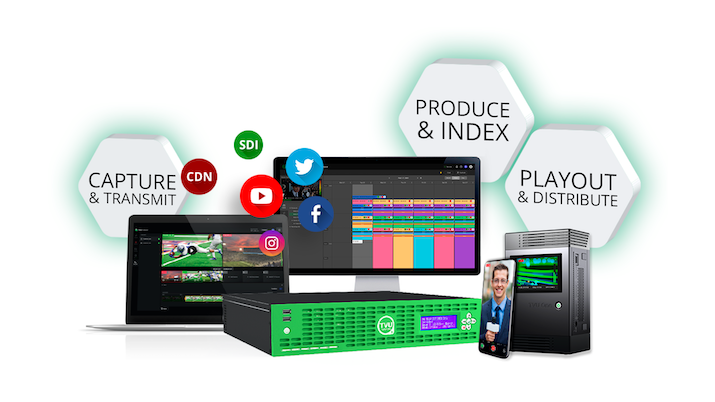
TVU Networks promoted its TVU Cloud ecosystem, under which several solutions work together seamlessly.
TVU Networks (Stand 5.C73) is prioritizing a handful of initiatives at IBC 2022. Notably, the company is pushing its TVU Cloud ecosystem, which ensures greater bandwidth and resiliency, ultra-low latency, and connectivity with speeds up to 100 times as fast as 4G. Within this ecosystem, several solutions work together to seamlessly provide a reliable solution: TVU One mobile transmitter, mobile devices leveraging the TVU Anywhere app, the TVU RPS remote-production system for encoding and decoding, TVU Producer to enable live streaming, TVU Partyline for real-time collaboration, TVU Remote Commentator for offsite analysis, and TVU Channel for remote playout. In addition, the company is highlighting an upgrade to TVU Channel: TVU Channel Plus. This free-to-use service enables customers to schedule live and VOD programming through a simplified web-based platform.
Two companies underneath the Verbit umbrella — VITAC (Stand 5.G36) and Take 1 — are exhibiting the latest updates on accessibility trends. Taking the “Content. Everywhere” stage on Monday, Sept. 12, VITAC and Take 1 access service manager Scott Henderson will participate in a panel discussion about making visual content more accessible to all audiences. Both companies are also available to discuss the various offerings of live and offline captioning, transcription, subtitling, and audio-description services.
HALL 7
Adder Technology (Stand 7.B18) is boosting the KVM game with its presence at IBC 2022. To serve current trends in the industry, the company always adapts products to match the requirements of the client base. This week, Adder Technology is showcasing solutions that cater to the growing need for remote production and utilization of cloud-based workflows. Whether it’s a production hub in a traditional broadcast facility or a newly minted control room inside a professional sports venue, users are able to tap into the physical workspace from the comfort of their own home. In-venue shows and live broadcasts alike are being prepared properly from anywhere in the world.
The move to HDR production is one of the newest challenges in the industry and AJA Video Systems (Stand 7.C19) aims to make the process easier than ever with ColorBox, priced at U.S.$1,995 and shipping now. The box, four of which can fit side by side in one traditional rack unit, is a converter for color-managed workflows for broadcast, live, or on-set needs. A 33-point 3D LUT processor with tetrahedral interpolation can make use of internal LUTs from Colorfront, NBCU, and AJA Color Pipeline as well as licensed versions of BBC HLG and new ORION-CONVERT. Latency is less than one line; a set of web-based controls (which can also be controlled by controllers from CyanView and Skaarhoj) offer increased flexibility; and built-in presets make things even easier. Said AJA senior product manager Tim Walker, “The presets allow you to create a look and then, with the push of a button, create the exact mathematical inverse so that you have two matched presets for going from SDR to HLG or HLG to SDR or whatever conversion you need.”
Blackmagic Design (Stand 7.C49) is showing four new models of the Ultimatte 12 real-time compositing processor, with different versions at different price points and qualities available depending on the scope and level of the sports-broadcast graphics or virtual sets required or the television standard used. The SDI input Ultimatte 12 HD, Ultimatte 12 4K, and Ultimatte 12 8K models are accompanied by an HDMI input Ultimatte 12 HD Mini model. Designed specifically for live production, Ultimatte 12 features one-touch keying that analyses a scene and automatically sets more than 100 parameters so that customers get useful keys without having to do a lot of extra work. Also announced at IBC is a new Ultimatte Software Control app for Mac and Windows that’s available for download free of charge. This software lets users control all Ultimatte 12 models without the additional cost of a hardware control panel.
Brainstorm (Stand 7.B01) has made several announcements, including release of Suites 5.1 and 5.2 of the company’s InfinitySet and Edison 5.1 for live immersive presentations. As mixed-reality (MR) and extended-reality (XR) productions become entrenched in the industry, Suite 5.1 is dedicated to streamlining users’ ability to improve their virtual content creation, including content captured on LED video displays or other forms of background. Suite 5.2 works closely with Version 5 of Epic Games’ Unreal Engine rendering. Tapping a highly regarded platform like Unreal Engine, Brainstorm fully integrates objects created in InfinitySet or Aston and vice-versa. Edison 5.1 is essential to the experience on the newly introduced EdisonGO app, a mobile application that offers video and tracking information to Edison PRO.
The fruits of DataCore Software’s (Stand 7.D17) recent acquisitions of Caringo and MayaData are being showcased at IBC as part of its new DataCore NEXT vision. First, DataCore has joined forces with Symply to release an appliance-based product that streamlines media archiving. SymplyPerifery is powered by DataCore’s object-storage platform, Perifery, designed for appliances and edge devices. Using the appliance, media companies can offload content from their primary online storage system (SAN or NAS) to a local archive for short- and long-term reuse and re-monetization. Second, DataCore has unveiled the latest version of its Swarm object-storage solution (part of the Caringo acquisition). Swarm offers significant enhancements for onsite and public-cloud environments, including hybrid-cloud enablement, improved performance for video streaming, and lightning-fast metadata search capabilities.
EditShare (Stand 7.A35) is demonstrating a new integrated solution with Cinedeck running on AWS. Cinedeck’s live multicam video-ingest solutions have been integrated with EditShare’s storage and Media Asset Management solutions: EFS and FLOW. According to VP, product management, Sunil Mudholkar, the partnership allows media captured with Cinedeck hardware appliances or Capture2Cloud to be written directly to, respectively, on-premises EFS hardware or cloud-based EditShare EFS Flex systems. When assets are recorded by Cinedeck, a real-time Flow-compatible proxy file is created and immediately checked into FLOW for preview, searching, tagging, markers, and other metadata.
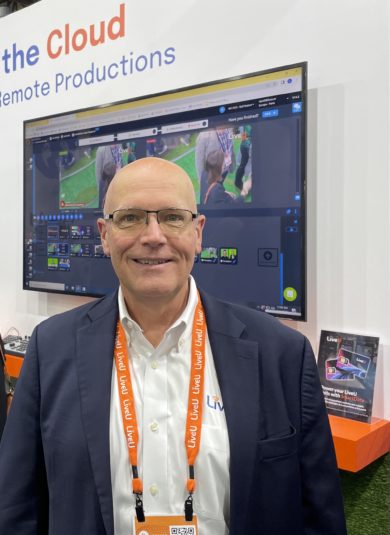 LiveU (Stand 7.C30) is promoting reliable workflows that cater to remote productions and services in the cloud. The company has released two significant products and improved an existing solution. According to LiveU VP, sales, Mike Savello, the LU810 and LU610S encoders are enabling 5G, 4, and synchronized, multi-camera contribution via LiveU’s Reliable Transport (LRT) protocol. Boasting flexibility and simplicity, these two appliances can be controlled from anywhere via the LiveU Central cloud management-platform interface. Additionally, the LiveU IP Matrix is enhanced with the introduction of the Matrix Transceiver for versatile switching between live-video distribution and contribution. Another product controlled by LiveU Central unified-management platform, Matrix Transceiver promises easy-to-use setup and full remote adoption.
LiveU (Stand 7.C30) is promoting reliable workflows that cater to remote productions and services in the cloud. The company has released two significant products and improved an existing solution. According to LiveU VP, sales, Mike Savello, the LU810 and LU610S encoders are enabling 5G, 4, and synchronized, multi-camera contribution via LiveU’s Reliable Transport (LRT) protocol. Boasting flexibility and simplicity, these two appliances can be controlled from anywhere via the LiveU Central cloud management-platform interface. Additionally, the LiveU IP Matrix is enhanced with the introduction of the Matrix Transceiver for versatile switching between live-video distribution and contribution. Another product controlled by LiveU Central unified-management platform, Matrix Transceiver promises easy-to-use setup and full remote adoption.
LiveU (Stand 7.C30) is a destination for sports producers, broadcasters, and federations looking for an end-to-end cloud-centred live-video and remote-production solution. Tier 2 and Tier 3 sports, in particular, are the focus for a workflow that incorporates the cloud master-control room easylive.io, which the company acquired in May 2022, with LiveU encoders and offers live contribution, cloud production, orchestration, ingest, and distribution. Adding the cloud layer is part of the company’s plan to “move away from being a backpack company”, said LiveU VP, Marketing, Ronen Artman. At the same time, the company has announced a tie-up with content-connectivity–solutions provider SES, which will provide an end-to-end solution for live video contribution and distribution combined with premium content aggregation. Ideal for sports, it allows delivery of live video across satellite, fibre, IP, and cellular.
LucidLink (Stand 7.B06) has teamed with AJA Video Systems and Telestream on a new cloud workflow based on LucidLink Filespaces SaaS-based solution. Filespaces provides rapid access to data through AJA Diskover Media Edition in conjunction with Telestream GLIM and the Vantage platform. LucidLink serves as a central hub uniting what is typically two disparate systems creating seamless workflows for media organizations. Alex Ferris, director, pre-sales engineering, LucidLink, says these combined technologies allow media professionals to access, organize, and view data in one easy workflow.
Monarch EDGE from Matrox (Stand 7.B15) is worthy of attention for IBC attendees seeking an encoder/decoder for remote productions that includes built-in tally and talkback, 4K, and genlock support. EDGE is said to offer “glass to glass” latency as low as 100 ms over a standard 1 GbE network and can handle up to four camera feeds from HD or 3G-SDI sources. The company says it offers “studio-quality productions from the road with less staff and equipment.” On the same stand, GlobalM is demonstrating a new edge transcoding and remultiplexing solution developed with the help of NVIDIA DeepStream technology, using NVENC and NVDEC to accelerate video encode and decode at the edge.
Newsbridge (Stand 7.B09) is celebrating after raising €7 million in a Series A funding round that will help it continue an expansion in the U.S. and hire additional AI and media-engineering talent. The company’s Cloud Media Hub platform for live and archived content uses multimodal AI Indexing to manage media assets. Unlike traditional AI, which relies on a single source for indexing, Newsbridge’s tech merges detection results from face, text, objects, pattern, and transcription to produce more-accurate metadata and search results. Among Cloud Media Hub’s modular features new at IBC is advanced speech-to-text recognition for subtitling, which deploys a technique called “AI diarization” to identify who speaks and when, recognising that there are people on screen and that their lips are moving.
Pixotope (Stand 7.D08) aims to democratize extended-reality productions with the debut of its XR Edition at IBC. With LED volume use in virtual production becoming more commonplace, Pixotope’s XR Edition comprises a range of tools to simplify setup and operation by reducing the technical complexities and associated resource costs of XR production. XR Edition features multi-wall support with one input and three outputs to render one virtual scene, enabling users to drive several large LED volumes from a single server/workstation. In addition, in-software camera switching allows users to synchronize AR elements and LED walls without a hardware-based switcher.
Quantum (Stand 7.C39) has announced the immediate availability of its StorNext file system as a subscription offering in AWS Marketplace without the need for hardware infrastructure buildout, custom configuration, or client-software installation. According to Quantum Marketing Director Skip Levens, AWS Marketplace is one of the fastest ways to deploy StorNext shared storage and lets users connect from any location to edit video in the cloud as a team. Physical and cloud instances of StorNext can easily move, sync, or replicate content to unify workflows and can ingest from or publish to cloud storage, such as ActiveScale, or Amazon S3 services like Glacier. Quantum has also rolled out physical gear at IBC, including its F2100 NVMe storage appliance and H4000 Essential storage platform — both of which debuted in April at NAB 2022.
Rohde & Schwarz (Stand 7.B21) is highlighting the constant yet gradual move from SDI to IP. Taking center stage on its stand is the R&S PRISMON: a fully software-based, IP ST 2110-ready solution that specializes in monitoring and multiviewing and prepares clients to make the leap to IP. Combining with the R&S PRIMSON — and the PRISMON Scalable Distributed Multiviewing (SDM) tool — is the new Multiviewer Control Centre (MCC). Through SDM, any user can permit PRIMSON to share resources across a network, Leveraging both MCC and SDM will enable customers using PRISMON to build highly efficient, scalable large multiviewing systems.
Faster speed to air and the ability to analyse football matches in a more compelling way are key developments offered in version 6 of Tactic Pro by RT Software (Stand 7.B11). The sports-telestration product now incorporates Next Gen Analysis, which delivers faster workflows for regular analysis and enables creation of more in-depth complex sequences using data gathered from professional-football coaching analysis. Several AI-assisted features in Next Gen Analysis enable a graphics sequence to be set up quickly, allowing an operator to invest more time building the more compelling analysis demanded by knowledgeable audiences and thereby helping take football “punditry” beyond the banal. At the same time, illustrating RT Software’s commitment to cloud deployment, the stand’s technical infrastructure is running in AWS. Experts are on hand to talk through the challenges customers should consider when adopting a cloud architecture, such as which GPU-enabled AWS Instance to use or, for private data centres, how to get the most out of shared GPU resources using vGPUs.
After acquiring Encoding.com in May, Telestream (Stand 7.C16) is showcasing the combined service of Encoding.com platform and the Telestream Media Framework (the underlying technology stack for nearly all Telestream products, including Vantage). With the Telestream Media Framework, Encoding.com can better support a larger variety of broadcast and postproduction workflows in the cloud with new capabilities for processing advanced codecs, transcriptions, more caption/subtitle formats, and a more robust automated QC service.
Sports broadcasters looking for advanced virtual-set technology might want to drop by the Zero Density (Stand 7.A59) exhibit. On show is TRAXIS talentS, an AI-powered markerless stereoscopic talent-tracking system that can identify the on-screen presenter or host inside a 3D virtual environment without the wearables. Location data is sent to Zero Density’s Unreal Engine-native platform Reality Engine from where accurate reflections, refractions, and virtual shadows can be created. Users can also automate graphics by location, trigger animations, and follow graphical “props”. Zero Density’s technology is used by BBC Sport on its Match of the Day programming and by IMG’s Premier League Productions for its international presentation studio. A new version of Zero Density’s Reality Hub control application is also on show. Version 1.3 includes a new form builder and separates user management into its own module.
